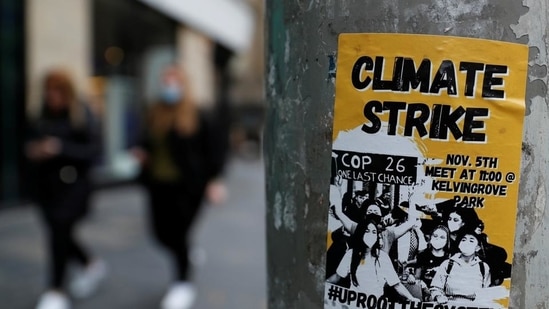COP26 draft urges boost to green goals by 2022
Without specifics, this is pretty much what anyone could have hoped to achieve in Glasgow in a best-case scenario, but it is the specifics that are likely to become contentious.
The COP26 climate conference that is to end on Friday entered its business end with the UK presidency team of COP releasing two draft agreements, aka cover decision, that set out some ambitious targets, including meeting the global warming target agreed upon in Paris in 2015, and the phasing out of fossil fuel subsidies, although India and other developing countries may yet push for stronger wording on the quantum and timing of climate finance.

One of the drafts, CMA.3, is basically a draft by the group of nations that were signatories to the 2015 Paris agreement; the other CP.26, was by the Conference of Parties. The CMA.3 draft is the one with more details on important issues, and will be the one discussed over the next two days.
Broadly, the draft urges countries to come back by the end of next year (2022) with stiffer emission reduction targets for themselves that will help meet the Paris target of keeping global waring to 1.5 degrees Celsius over pre-industrial levels ; recognises the need to double climate finance for developing and vulnerable countries; asks the UN chief to call for a meeting of leaders in 2023 to review the 2030 targets; and asks for the accelerated phasing out of the use of coal and of fossil fuel subsidies (without putting a deadline to these).
Without specifics, this is pretty much what anyone could have hoped to achieve in Glasgow in a best-case scenario, but it is the specifics that are likely to become contentious. Talks (or negotiations and bargaining) over the next few days will focus on these specifics. The decisions that COP will finally decide on are binding, although the final decision can also only be arrived at through consensus, which means the next two days are likely to see frenetic efforts by various groupings to shape the language to their advantage.
The draft, proposed by COP26 president Alok Sharma, underlines the Paris Agreement temperature goal of capping the rise in the average global temperature to well below 2°C above pre-industrial levels and also calls for pursuing efforts to limit the temperature increase to 1.5°C above pre-industrial levels.
It recognises that keeping global warming to under 1.5°C requires meaningful and effective action by all parties, reflecting common but differentiated responsibilities and respective capabilities in the light of different national circumstances. “The text doesn’t crisply, clearly articulate the 1.5 degree goal. It’s still a bit fuzzy,” said David Waskow, international climate director, World Resources Institute.
Meeting the 1.5°C goal would require reducing global CO2 emissions by 45% by 2030 relative to the 2010 level and to reach net zero by around mid-century. But the aggregate greenhouse gas emission level, taking into account implementation of all nationally determined contributions (NDCs) submitted, is estimated to be 13.7% above the 2010 level in 2030, the draft states. It is in that context that the revision of NDCs by 2022 becomes significant -- previously, countries were expected to do so only every five years, which would have meant 2025 or 2026 for most countries.
On climate finance, the draft urges developed countries to provide financial resources to developing nations with respect to both mitigation and adaptation, in continuation of their existing obligations under the convention. It also encourages all parties to provide such support voluntarily. It also calls upon “developed countries to at least double their collective provision of climate finance for adaptation”. Developing countries , including India, would have wanted more from the draft, but may have feared even less, and they will now push for quantifying this commitment and putting a timeline to it. The developed world, as evident from their stance over the past few days, will oppose this, and also seek to redefine climate finance to include investments from private companies, and not just grants.
Waskow added that a positive development in the draft is that parties have been urged to come forward by 2022 with revisited, improved NDCs. It also has language on phasing out coal and fossil fuel subsidies which have been named specifically in the text, perhaps for the first time. This is also an issue that is likely to see the most jockeying.
A significant inclusion in the draft is a “work programme” on enhancing mitigation targets and “implementation during the critical decade of the 2020s”. If this finds a way in the final agreement, it means mitigation targets and achievements (in terms of emissions) will be tracked regularly, at least in every future COP, analysts explained.
“I think the draft only captures the mood here and the various asks giving direction to what we need to do. These are very difficult negotiations and we are not yet happy with developments on climate finance. I still hope there will be a landing zone. The draft, of course, will change,” said a member of the Indian delegation in response to the draft text.






